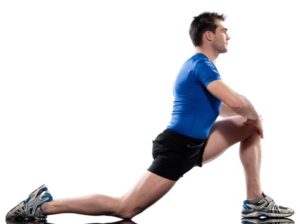Best Stretches for Sports Hernia Prevention

What exactly is a sports hernia? It’s a difficult-to-diagnose injury that is caused by repetitive movements that many sports—such as tennis, running, basketball, dancing, wrestling, football, hockey, and soccer—involve.
Not only can a sports hernia develop from repetitive movement; it can also happen as a result of a sudden twisting motion. When a sports hernia occurs, it can cause truly debilitating pain that remains persistent and can threaten the performance of many athletes. Because these injuries are severe and have the potential to hurt an otherwise great sports career, it’s very important for athletes to do their best to prevent sports hernias from happening.
What’s one of the best ways to prevent a sports hernia?
Stretching! Do this before engaging in any type of sport—or any strenuous activity, for that matter. When you stretch, you’re helping your muscles become more flexible and therefore less likely to become injured.
The best stretch for sports hernia prevention is a standing groin stretch, since the groin is where sports hernias develop. To do a standing groin stretch, simply spread your legs into a wide position while standing and bend one knee, leaning sideways. Maintain this pose for 30 seconds, and repeat this a few times a day. This will greatly improve your flexibility.
Besides the standing groin stretch, athletes can also try the butterfly stretch. This one is done sitting down. Sit with your back straight and touch the bottoms of your feet together. Bring your knees up to your elbows, while bringing your feet closer to your body. This stretch will strengthen the inside groin area, which is the main spot for sports hernias.
These stretches are great for prevention, and another good thing for athletes to do is any exercise that works the core. Lunges will strengthen your lower abdomen and your groin, and classic exercises such as planks and crunches will help build resistance. When you do lunges, make sure that your back is straight and that your feet line up with your shoulders and knees.
If you happen to already have a sports hernia, these same exercises help with that, too, by strengthening the proper muscle groups to prevent sports hernias from coming back.
How do you know if you have a sports hernia? There’s no way to really know until you get a diagnosis from a specialist; however, the signs of this condition include pain in the lower abdomen, groin, thigh, or testicles that gets worse with activity, and can also be felt while lifting or during a cough, laugh, or sneeze. This pain may get better with rest, but returns when you get back on the field and compete. The best thing to do is to find out for sure, before it gets worse and more painful.
One of the best sports hernia specialists in the country, Dr. William Brown, has been researching and repairing sports hernias for nearly two decades. If you suspect that you have a sports hernia, it’s important to see a sports hernia specialist immediately in order to get treatment and stop further damage. Please contact Dr. William Brown with any questions you may have, or to schedule an appointment.

Well explained.I had a hernia surgery last year. Recommendation for post operation hernia prevention Dr. Michael Reinhorn,very devoted man.